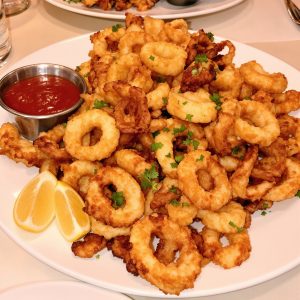
AI generated image
Chef's Tip
For the crispiest results, maintain oil temperature between 350-375°F and fry each type of seafood separately as they require different cooking times. Always let excess batter drip off before frying to prevent the coating from becoming too thick.
Instructions
- Prepare the tartar sauce by combining mayonnaise, chopped pickles, capers, dill, and lemon juice in a small bowl. Refrigerate until ready to serve.
- Pat all seafood dry with paper towels. Season lightly with salt and pepper.
- In a large bowl, whisk together flour, cornmeal, baking powder, Old Bay, salt, pepper, and garlic powder.
- Pour buttermilk into a separate bowl.
- Set up your breading station: seafood, buttermilk, and then the flour mixture.
- Heat oil in a large, heavy-bottomed pot or Dutch oven to 365°F, using a thermometer to monitor temperature.
- Working in batches by type (clams first, then scallops, shrimp, and finally fish), dip each piece first in buttermilk, then dredge in the flour mixture, shaking off excess.
- Carefully lower coated seafood into hot oil, being careful not to overcrowd.
- Fry clams for 1-2 minutes, scallops for 2-3 minutes, shrimp for 2-3 minutes, and fish for 3-4 minutes, or until golden brown and cooked through.
- Remove with a slotted spoon or spider and drain on a wire rack set over a baking sheet. Immediately season with a light sprinkle of salt.
- Maintain oil temperature between batches, allowing it to return to 365°F before adding the next batch.
- Serve hot with prepared coleslaw, french fries, tartar sauce, and lemon wedges.
Plating
Arrange the different types of fried seafood in sections on a large platter or individual plates. Place french fries in one section and coleslaw in a small side dish. Add ramekins of tartar sauce and lemon wedges. For traditional presentation, line the serving plate with parchment paper or a basket with wax paper.
Storage & Reheating
Fried seafood is best enjoyed immediately after cooking. Leftovers can be stored in an airtight container in the refrigerator for up to 1 day. To reheat, arrange in a single layer on a baking sheet and warm in a 350°F oven for 5-7 minutes. The tartar sauce can be refrigerated for up to 5 days.
About This Recipe
This New England fried seafood platter draws inspiration from The Barnacle's coastal tradition. The variety of seafood offers different textures and flavors, all united by a light, crispy coating. This home version adapts the restaurant technique with careful temperature control and proper handling of each seafood type to create an authentic seaside dining experience.
